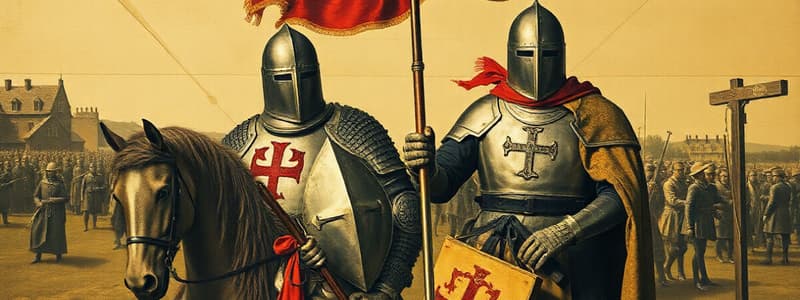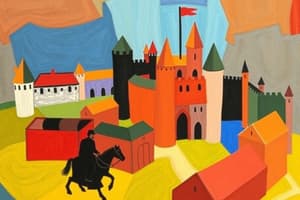Podcast
Questions and Answers
Which of the following best describes the primary exchange in the feudal system?
Which of the following best describes the primary exchange in the feudal system?
- Money for goods and services
- Education for social mobility
- Labor for religious salvation
- Land for military service (correct)
Chivalry primarily dictated a knight's behavior towards peasants and serfs.
Chivalry primarily dictated a knight's behavior towards peasants and serfs.
False (B)
What was the significance of the carruca in medieval agriculture?
What was the significance of the carruca in medieval agriculture?
It improved farming on tough soils.
A peasant legally bound to the land in the manorial system was known as a ______.
A peasant legally bound to the land in the manorial system was known as a ______.
Match the following terms with their descriptions:
Match the following terms with their descriptions:
Which factor was most crucial in enabling the revival of trade in medieval Europe?
Which factor was most crucial in enabling the revival of trade in medieval Europe?
The bourgeoisie primarily consisted of nobles and clergy.
The bourgeoisie primarily consisted of nobles and clergy.
How did the three-field system contribute to increased agricultural output?
How did the three-field system contribute to increased agricultural output?
A formal agreement between two parties is called a ______.
A formal agreement between two parties is called a ______.
What was the main function of guilds in medieval towns?
What was the main function of guilds in medieval towns?
Common law varied from region to region within England.
Common law varied from region to region within England.
What was the Domesday Book, and why was it significant?
What was the Domesday Book, and why was it significant?
The Magna Carta, signed in 1215, ______ the power of the king.
The Magna Carta, signed in 1215, ______ the power of the king.
Philip II Augustus of France is best known for which achievement?
Philip II Augustus of France is best known for which achievement?
Germany successfully unified into a single nation during the medieval period due to strong central leadership.
Germany successfully unified into a single nation during the medieval period due to strong central leadership.
Which culture had a significant impact on Spain during the medieval period?
Which culture had a significant impact on Spain during the medieval period?
Define the Reconquista in Spain.
Define the Reconquista in Spain.
England's representative government, including nobles and elected officials, is called ______.
England's representative government, including nobles and elected officials, is called ______.
Which of the following areas of Europe saw the formation of Kievan Rus?
Which of the following areas of Europe saw the formation of Kievan Rus?
Flashcards
Feudalism
Feudalism
A system where nobles gave land to vassals for military service.
Vassal
Vassal
A warrior who served a lord in battle.
Knight
Knight
A heavily armored soldier on horseback.
Fief
Fief
Signup and view all the flashcards
Feudal Contract
Feudal Contract
Signup and view all the flashcards
Chivalry
Chivalry
Signup and view all the flashcards
Technology
Technology
Signup and view all the flashcards
Carruca
Carruca
Signup and view all the flashcards
Manor
Manor
Signup and view all the flashcards
Serf
Serf
Signup and view all the flashcards
Bourgeoisie
Bourgeoisie
Signup and view all the flashcards
Patrician
Patrician
Signup and view all the flashcards
Common Law
Common Law
Signup and view all the flashcards
Magna Carta
Magna Carta
Signup and view all the flashcards
Parliament
Parliament
Signup and view all the flashcards
Estate
Estate
Signup and view all the flashcards
Study Notes
Feudalism
- Feudalism is a system where nobles gave land to vassals in exchange for military service.
- A vassal was a warrior who served a lord in battle.
- A knight was a heavily armored soldier on horseback.
- Fief refers to land given to a vassal by a lord.
- Feudal Contract refers to the unwritten rules between a lord and his vassal.
- Chivalry was a knight’s code of honor, encompassing loyalty, bravery, and respect.
Knights and Chivalry
- Knights needed bigger horses to carry heavy armor and weapons, making them stronger in battle.
- Ideals of chivalry included loyalty to the lord, protecting the weak and the Church, honor in battle, fair treatment of prisoners, and respect toward noblewomen.
Weakening of Europe
- After Charlemagne’s death, Europe weakened due to the empire being divided among his grandsons, and attacks by Vikings and other invaders.
The Start of Feudalism
- Feudalism started because kings became too weak to protect people.
- People turned to nobles for protection, who gave land (fiefs) to vassals for military service in return.
Structure of Feudal Society
- King: Gave land to powerful nobles.
- Lords/Nobles: Owned land and had vassals.
- Knights: Fought for lords and received land.
- Peasants/Serfs: Worked the land for protection.
Technology and Farming
- Carruca: A heavy, iron plow that improved farming.
- Manor: A large estate run by a lord and worked by peasants.
- Serf: A peasant legally tied to the land, working for a lord.
Society
- Bourgeoisie: The middle class, including merchants and traders.
- Patrician: A wealthy and powerful landowner or noble.
Patricians
- Citizens allowed patricians to control elections because they were wealthy and powerful, controlling trade, land, and government; citizens depended on them for jobs and protection.
Growth of Cities
- Better farming led to more food, which led to more people surviving, and trade revival brought more merchants and artisans to cities.
- Money economy caused people to use coins instead of bartering.
Farming Methods Effect on Europe
- Carruca plow allowed better farming on tough soil, the three-field system kept soil fertile and increased food production, and more food led to a population doubling from 38 million to 74 million.
Life in the Manorial System
- Nobles lived in manors, controlled land, and had serfs to work for them.
- Serfs were legally tied to the land and worked three days a week for the lord; they grew their own food but paid rent and taxes and could not leave without permission.
Trade Revival
- Increased trade led to more markets and trade fairs, the start of a money economy, the formation of guilds, and the growth of banking and business, leading to capitalism.
Growth of Medieval Cities
- Trade revival led to merchants and artisans moving to cities, safer towns after Viking invasions stopped, a money economy where people worked for wages, and guilds and businesses creating jobs and opportunities.
Legal
- Common Law: A legal system based on court decisions and customs, rather than written codes.
- Magna Carta: A document signed in 1215 that limited the power of the king.
- Parliament: A representative government in England, including nobles and elected officials.
- Estate: A social or political class in medieval society.
Common Law
- Common law was better than local law codes because it created one legal system for all of England, replacing different laws in each town or region improving justice.
Events in Europe
- England: In 1066, William of Normandy won the Battle of Hastings and became king; in 1215, the Magna Carta was signed, limiting the king’s power, and Parliament was created under Edward I.
- France: Philip II Augustus (1180-1223) expanded French territory, Louis IX improved justice, and Philip IV created the Estates-General (French Parliament).
- Holy Roman Empire: Otto I became the first "Holy Roman Emperor" in 962; Frederick I & II tried to control Italy but failed, and Germany remained divided into small states.
England Post 1066
- William of Normandy became king and took a census (Domesday Book), common law replaced local laws, the Magna Carta limited the king’s power, and Parliament was created.
Philip II Augustus
- Philip II Augustus was important for France because he expanded French territory, increased royal power over nobles, and strengthened the government and economy.
Germany and Italy
- Germany and Italy did not unite into one country because Holy Roman Emperors focused on controlling Italy, German nobles became too powerful, and constant wars weakened the empire.
Muslim Rule
- Spain was ruled by Muslims (Al-Andalus) for centuries, Christians and Jews could practice their religion but had restrictions, Islamic culture influenced Spain, and the Reconquista lasted for 500+ years.
Slavic Kingdoms
- Western Slavs created Poland and Bohemia, Eastern Slavs formed Kievan Rus (early Russia), and Southern Slavs included Serbs, Croats, and Bulgarians.
Studying That Suits You
Use AI to generate personalized quizzes and flashcards to suit your learning preferences.




